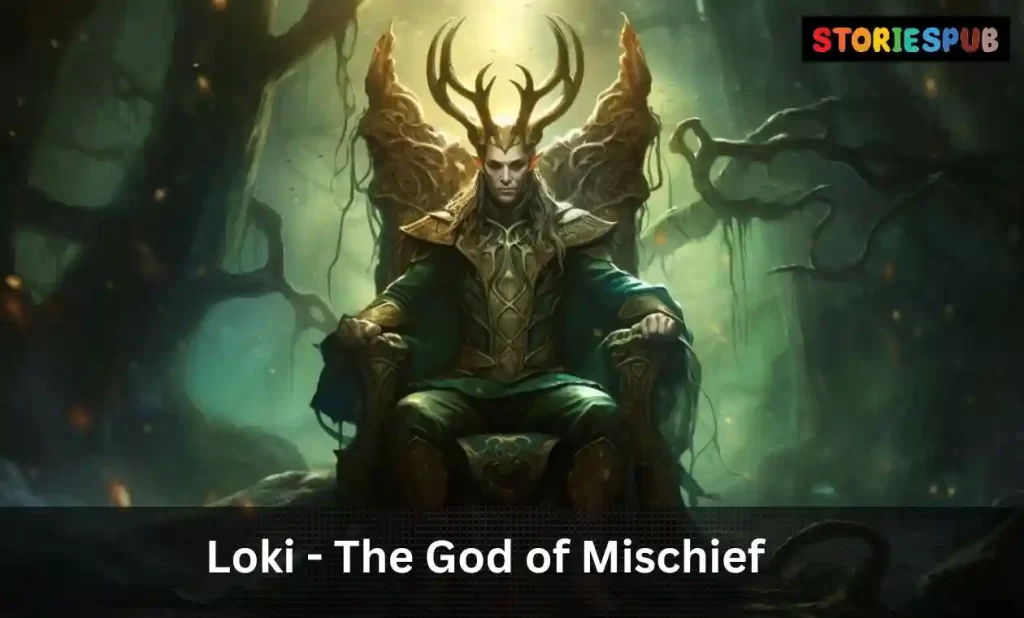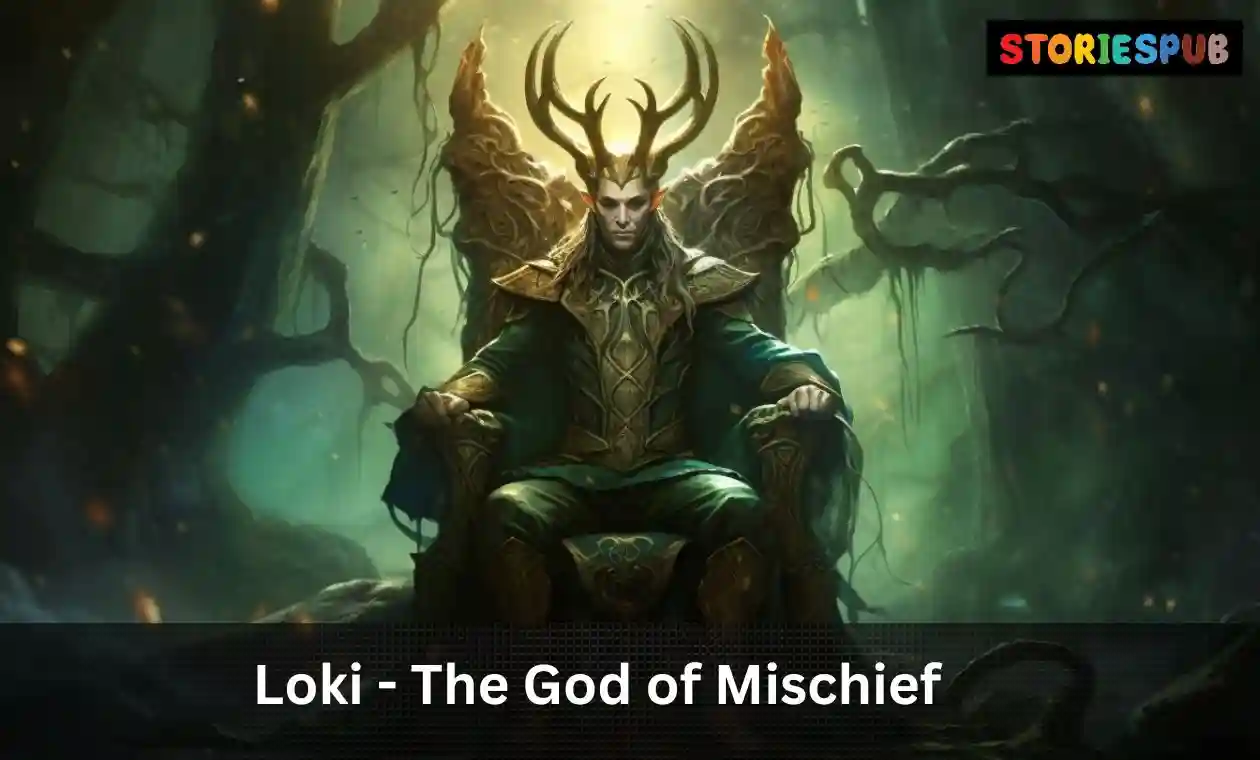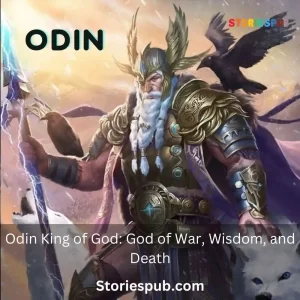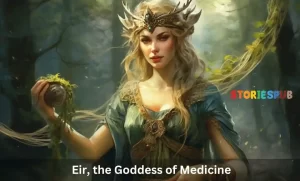Loki – The God of Mischief in Norse Mythology

Introduction
Norse mythology is a rich and fascinating collection of stories and legends that offer insight into the customs, beliefs, and values of the people who inhabited Northern Europe during the Viking Age. At the center of this mythological world are a pantheon of gods and goddesses who interact with each other and with mortals in complex ways. The myths are filled with heroes, monsters, magical artifacts, battles, romance, tragedy, and humor.
Loki is one of the most intriguing characters in Norse mythology because he defies easy categorization. He is a god but also a trickster figure who often causes mischief and chaos.
He has been called both a friend and an enemy to the other gods. Some myths describe him as clever and cunning while others portray him as selfish and untrustworthy.
Brief Overview of Norse Mythology
Before we delve further into Loki’s story, it is important to provide some context about Norse mythology as a whole. According to these myths, before there was anything else in existence there was only Ginnungagap – an empty gap between two worlds: Muspelheim (the land of fire) on one side, Niflheim (the land of ice) on the other side. Eventually fire from Muspelheim met ice from Niflheim in Ginnungagap creating Ymir – the first giant creature who gave rise to many more giants that populated his realm known as Jotunheim.
The rest of creation slowly emerged around Yggdrasil – The World Tree which connects all nine worlds in Norse cosmology. Three beings known as Odin (god of wisdom), Vili (god or willpower) and Ve (god or holiness), killed Ymir due to fear he might grow too powerful.
From his body they created Midgard – home to humans; Asgard – home to gods, and various other realms. The gods were the rulers of Asgard, dwelling in a great hall called Valhalla.
They were led by Odin, the All-Father, who was associated with wisdom, war, and death. Other important gods and goddesses included Thor (god of thunder), Freyja (goddess of love and fertility), Baldr (god of light), and Heimdallr (the watchman who guards Bifrost-the rainbow bridge between Midgard Earthly world- and Asgard).
Introduction to Loki as a Trickster God
Loki is often described as a trickster god because he is known for his cunning behavior that leads to chaos. He is also considered a shape-shifter since he can transform into various animals or objects at will. Despite his reputation for causing trouble, Loki was still an important member of the Norse pantheon.
He was not only the god of mischief but also the god of fire which made him instrumental to many myths like building walls around Asgard with help from Freyja’s magical artifacts gifted in exchange for her hand in marriage; Being the mother – yes mother – who gave birth to Sleipnir – Odin’s eight-legged horse that carried him across all worlds; Challenging Thor to fetch giant magical cauldron “Gjallarhorn” from Jotunheim which resulted in hilarious adventures while testing Thor’s strength. Loki’s character has been interpreted differently through time which we’ll go on about later in this article however one thing remains constant: Loki’s actions always have consequences for all those around him.
Early Life and Family
Loki is one of the most complex figures in Norse mythology, known for his cunning and ability to change his shape at will. According to Norse mythology, Loki was the son of the giant Farbauti and Laufey. His siblings included Helblindi and Byleistr.
Loki was not considered a direct part of the Aesir gods, but he often interacted with them and played a major role in their lives. Loki’s marriage to Sigyn was an interesting aspect of his life.
She is often portrayed as loyal to her husband despite his mischievous ways. Together they had two sons, Narvi and Vali.
Unfortunately, their happiness did not last long as their sons were killed in a cruel act by the other gods as punishment for Loki’s misdeeds. Loki’s relationship with the Aesir gods was complicated from the start.
Though not one of them directly, he frequently interacted with Thor, Odin, Freya, and other members of this powerful pantheon. One story tells that when Odin saw Loki for the first time as a child he was so impressed with him that he took him into Asgard to be raised among the other gods.
However, this upbringing did not stop him from causing trouble. As a young godling growing up among giants and giants’ offspring in Jotunheimr (the world inhabited by giants), Loki would occasionally venture over to Asgard (the world inhabited by gods) where he would play pranks on his fellow deities or otherwise stir up trouble – including cross-dressing!
This led some later writers to speculate that perhaps Loki might have been gender-fluid or bisexual. Loki’s early years were marked by mischief-making even before he entered Asgard proper – setting a pattern that would continue throughout his life; however it wasn’t all just fun-and-games for the god of mischief, as his marriage to Sigyn and the loss of their children demonstrates.
The Mischief and Chaos of Loki
The Pranks of the Trickster God
Loki is known throughout Norse mythology for his mischievous nature. He is a troublemaker who takes delight in causing chaos and confusion among the gods. One of his most famous pranks was stealing Thor’s hammer, Mjolnir.
Loki amused himself by hiding the hammer, which had been crafted by dwarves, and watching as Thor searched for it in vain. The trickster only relented when the goddess Freyja suggested that they all wear bridal dresses in order to retrieve it from the giant who had stolen it.
Another one of Loki’s well-known pranks involved cutting off Sif’s golden hair. Sif was the wife of Thor and her hair was considered one of her most beautiful features.
When Loki cut it off, he caused great distress to both Sif and Thor. However, he eventually made amends by commissioning dwarves to craft new hair for Sif – this time made entirely of gold.
The Death of Baldr
While some of Loki’s antics were harmless pranks, others had more serious consequences. Perhaps his greatest act of mischief was his involvement in the death of Baldr, one of the most beloved gods in Norse mythology.
Baldr was known for his beauty and goodness, and he was beloved by all who knew him – including Loki himself. However, this affection did not stop him from devising a plan to kill Baldr with an arrow made out of mistletoe – one of the few substances that could harm him.
Loki convinced Hodr, Baldr’s blind brother, to shoot the arrow at Baldr during a game between the gods where they would throw objects at him knowing he could not be hurt due to his invulnerability being guaranteed by Frigg’s oath to protect him. The arrow hit its mark and Baldr died instantly, plunging the entire Norse world into mourning.
The Consequences of Chaos
Loki’s actions did not go unpunished. As a result of his part in Baldr’s death, he was chained to a rock with venom dripping onto his face as punishment for eternity. This torture was only halted temporarily by the intervention of Loki’s loyal wife, Sigyn, who caught the venom in a bowl – but this ended when she had to empty it and it hit him again.
Despite his punishment, however, Loki remained a central figure in Norse mythology. He continued to cause mischief and chaos even while imprisoned, and his eventual release during Ragnarok marked the beginning of the end for the gods.
Pop Culture Depictions of Loki
Loki has remained an enduring figure in popular culture thanks to his complex personality and mischievous nature. He has been portrayed in various different ways over the years – sometimes as a villainous trickster who revels in chaos and destruction, other times as a more sympathetic figure struggling with his own identity.
Perhaps one of the best-known depictions of Loki is from Marvel Comics’ “Thor” series. Here he is depicted as Thor’s half-brother who is constantly causing trouble for both Thor and the rest of Asgard.
The character proved so popular that he was eventually given his own standalone movie – “Loki” – which delved deeper into his characterisation beyond simply being a foil for Thor. Overall, whether seen as hero or villain depending on interpretation or context, Loki remains one of Norse mythology’s most fascinating figures – an eternal reminder that even gods can be flawed beings capable of both great good…and terrible evil
Punishment and Redemption
The punishment inflicted on Loki by the other gods for his misdeeds
Loki’s many misdeeds eventually caught up with him, and the other gods decided to punish him for his actions. They bound him to a rock using the entrails of one of his sons, and placed a venomous snake above his head. The snake would drip venom onto Loki’s face, causing him intense pain that he was unable to escape from.
This punishment was meant to last for eternity, but it was not without its loopholes. Sigyn, Loki’s loyal wife, stayed by his side throughout his punishment.
She held a bowl above his head to catch the venom as it dripped down, sparing him some of the agony. Whenever she had to leave to empty the bowl, however, the venom would hit Loki full force.
His eventual release from captivity
Loki’s release from captivity came about during Ragnarok, the Norse apocalypse. He had been imprisoned for centuries at this point due to his treachery against the gods. However, as part of their last stand against their enemies during Ragnarok – namely giants and monsters – Odin realized that they needed all hands on deck if they were going to have any hope of surviving.
So Odin sends word down into Helheim (the Norse underworld) asking if he can borrow someone with enough power and cunningness that can help them defeat their enemies in Ragnarok. Loki agreed to help since he always had something up in his sleeves.
And so it was that Loki fought alongside the gods once again during Ragnarok. Though he did not ultimately survive this final battle himself either.
His role in Ragnarok: A traitor until death?
Loki played an important role in Ragnarok beyond just fighting alongside Odin and the other gods. According to Norse mythology, it was Loki who was ultimately responsible for bringing about the end of the world.
Loki’s role in Ragnarok was not that of a hero. He did provide crucial help to the gods, but ultimately his deception and treachery had put them in this position in the first place.
It is said that he led an army of giants and monsters against the gods during Ragnarok, fighting against those who he had once called his allies. In the end, however, Loki too met his fate during Ragnarok.
He fought valiantly until his death at the hands of Heimdallr, one of Odin’s most trusted warriors. His actions during Ragnarok may have been what sealed his status as a trickster god for all eternity.
Discussion on Interpretations
There are many interpretations of Loki’s punishment and redemption within Norse mythology. Some see it as a definitive statement on his character – that despite moments of loyalty and heroism, Loki was ultimately a traitor to his fellow gods and deserved what he got. Others view it more sympathetically as an example of how even someone who has made mistakes can find redemption if they are willing to fight for it.
In this interpretation, Loki’s willingness to fight alongside Odin during Ragnarok is seen as proof that he truly did care about Asgard and its inhabitants in spite of everything else. Ultimately, how you interpret Loki’s punishment and redemption will depend on your own personal views regarding justice and morality – as well as how you view Loki himself as a character within Norse mythology.
Conclusion
Loki’s punishment and eventual release from captivity – not to mention his role in Ragnarok – are just some examples of how complex this trickster god really is. Whether you see him as a villain or an antihero will depend largely on your personal beliefs about right and wrong, but there can be no denying the impact that Loki has had on Norse mythology and popular culture alike. His story is one of mischief, chaos, and ultimately redemption – a tale that will continue to inspire and intrigue readers for generations to come.
Interpretations of Loki
Different interpretations of Loki in Norse mythology
Loki’s character has been interpreted in various ways throughout Norse mythology. While many view him as a trickster god who causes chaos and mischief, others see him as a complex and multifaceted figure with both positive and negative qualities.
In some texts, Loki is portrayed as a cunning and intelligent god who uses his wit to outsmart his enemies. He is often seen as a master of disguise and illusion, able to take on different forms to achieve his goals.
However, in other tales, he is depicted as selfish and cruel, willing to betray even his closest allies for personal gain. One interpretation of Loki’s character is that he represents the chaotic and unpredictable forces of nature.
As such, his actions may be seen as necessary for maintaining balance in the world. In this sense, he is not necessarily good or evil but simply a force to be reckoned with.
How he has been portrayed in popular culture
Loki has become an increasingly popular figure in modern pop culture. In Marvel Comics’ Thor series, he is portrayed as the adoptive brother of Thor and a master manipulator who seeks power at any cost. This version of Loki has become one of the most iconic villains in comic book history.
The Marvel Cinematic Universe has also brought Loki to life on the big screen, with actor Tom Hiddleston playing the role since 2011’s “Thor”. Hiddleston’s portrayal has won critical acclaim for its complexity and nuance, showcasing both the mischievous charm and malevolent cruelty that define Loki’s character.
Outside of comics and movies, Loki appears in video games such as “Gods Among Us” (2013) where he plays an important role in the story mode by driving several characters’ stories forward. In addition to his appearances in popular media, Loki has also inspired a subculture of fans who are drawn to his complex nature and irreverent humor.
Many fan communities have emerged online, with members creating fan art, fan fiction, and cosplay based on the character. Overall, Loki’s enduring popularity in modern culture testifies to the lasting appeal of trickster figures and the human fascination with characters that blur the lines between good and evil.
Conclusion
Loki is one of the most fascinating and complex figures in Norse mythology. As a trickster god, he often caused chaos and mischief, but his story also includes moments of redemption that showcase his multifaceted nature.
Throughout his life, Loki was known for being cunning, unpredictable, and quick-witted. He was a master of deception and could twist the truth to suit his needs.
His pranks often left other gods feeling frustrated or angry, but they also kept things interesting in Asgard. Despite all of this, Loki’s story is not entirely one-dimensional.
He also displayed loyalty and love towards his family members. His love for Sigyn was so great that even after he was punished by the other gods and bound to a rock with a snake dripping venom into his eyes, Sigyn stayed by his side to catch the venom in a bowl before it could harm him.
Another example of Loki’s complexity can be seen in his role during Ragnarok. Although he played a key part in the events leading up to the apocalypse, some sources suggest that he did so out of necessity rather than malice.
In doing so, he helped pave the way for a new world to be born out of the destruction of the old one. Overall, Loki’s story serves as an important reminder that even those who seem irredeemable may have more depth than meets the eye.
While there’s no denying that Loki caused chaos and mischief throughout much of Norse mythology, it’s also worth remembering that he had moments when he acted selflessly or showed genuine affection towards others. In today’s world where villains are often portrayed as purely evil with little nuance or redeeming qualities, Loki stands out as an example of how complex characters can be just as compelling from both an entertainment standpoint and from what we can learn about ourselves through examining our own multifaceted natures.
Hey kids, how much did you like The Loki – The God of Mischief in Norse Mythology ? Please share your view in the comment box. Also, please share this story with your friends on social media so they can also enjoy it, and for more such Norse Mythology, please bookmark storiespub.com.
Related Post :
Loki FAQ
What is Loki's role in Norse mythology?
Loki is known for causing trouble and stirring up chaos, but he also plays a role in several important myths, including the death of the god Baldr and the binding of the giant wolf Fenrir.
What does Loki look like?
Loki is often depicted as a handsome man with long hair, but he can also transform into different shapes, including animals like a snake or a fish.
Is Loki worshipped in modern times?
Loki is not worshipped as part of any organized religion in modern times, but he is still studied and appreciated by scholars and enthusiasts of Norse mythology.
What is the significance of Loki in Norse culture?
Loki represents the idea of mischief and trickery, as well as the importance of balance and order in Norse culture.
Are there any symbols associated with Loki?
Loki is often associated with the image of fire, as well as with the concept of deception and chaos.
Is Loki similar to other trickster figures in other mythologies?
The concept of a trickster figure is found in many mythologies throughout the world, and there are some similarities between Loki and other trickster figures, such as the Greek god Hermes and the Native American figure Coyote.
Are there any stories involving Loki?
Loki appears in several Norse myths, including one in which he steals the goddess Idun and her magical apples, and another in which he is punished by having a snake drip venom onto his face.
Are there any modern adaptations of Loki in popular culture?
Loki has been adapted in various forms in popular culture, including in comic books, movies, and television shows. He is often portrayed as a charismatic and complex character who can be both hero and villain.
What is Loki's relationship with the other gods in Norse mythology?
Loki is often considered an outsider among the Norse gods, and his mischievous behavior often brings him into conflict with other gods, particularly Odin. However, he also forms alliances and friendships with certain gods, such as Thor.





